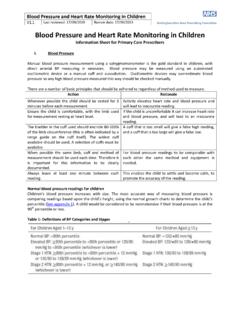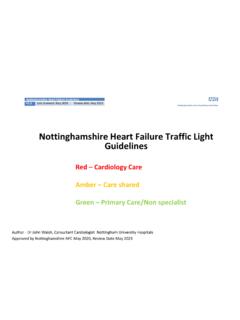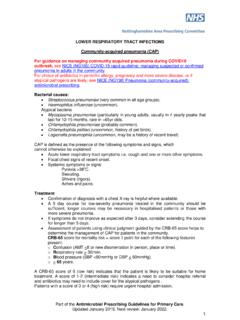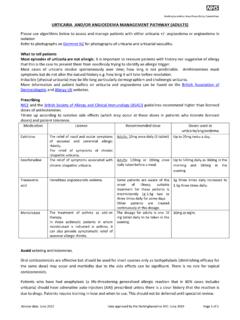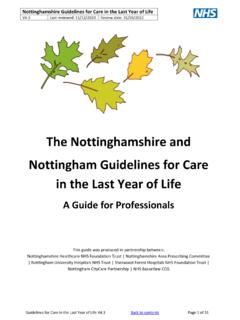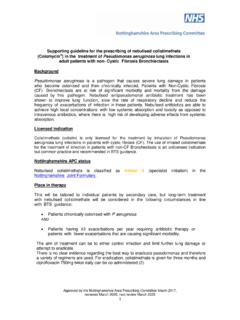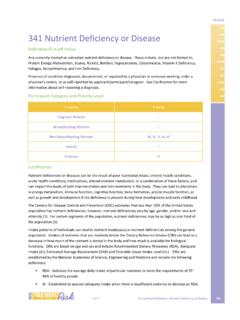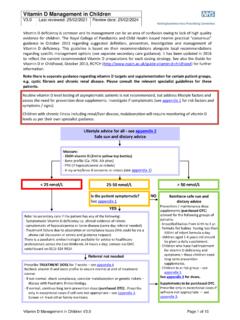Transcription of Vitamin D Management in Adults - NottsAPC
1 Vitamin D Management in Adults Last reviewed: 25/02/2021 Review date: 25/02/2024. NICE recommends that health professionals should NOT routinely test people's Vitamin D status unless: They are considered to be at particular high risk or they show clinical features of deficiency - see appendix 1. There is a clinical reason a metabolic factor (Specialists may test other specific patient groups if necessary). Test before starting patients on an antiresorptive agent IV zoledronic acid or denosumab or oral osteoporosis therapy if not going to be co-prescribed Vitamin D containing supplements. Initiate lifestyle interventions - see appendix 2. Measure 25OH Vitamin D. Also arrange: U+Es, LFTs, Bone profile, and PTH if calcium < mmol/L or > < 30 nmol/L 30-50 nmol/L > 50 nmol/L. Treat only if one or more of following applies: No treatment required Fragility fracture / osteoporosis / high fracture risk Maintain Vitamin D.
2 Medicine treatment for bone disease through safe sun TREAT Symptoms suggestive of Vitamin D deficiency - appendix 1. NO exposure and diet /. Increased risk of developing Vitamin D deficiency supplement use (OTC). Reduced UV exposure, raised PTH, treatment with More info in appendix 2. anticonvulsants or glucocorticoids, malabsorption and click here for patient If treatment not required reinforce lifestyle advice leaflet. YES. Does the patient have any of the following? YES Consider referral to 2. eGFR < 30 ml/ appropriate speciality for advice Hypercalcaemia Granulomous conditions sarcoidosis, active TB. Consider loading regimen NO (Approximately 300,000 units YES colecalciferol orally over 6-10 weeks). Is the patient symptomatic or about to start zoledronate or denosumab? - see table 2 in appendix 4. (prescribe by brand).. InVita D3 50,000 unit capsules . NO Take one capsule once a week for 6.
3 Weeks Routine replacement / maintenance therapy OR.. (for less urgent replacement and maintenance therapy) InVita D3 50,000 unit/1ml oral Is calcium intake sufficient ( 700mg per day)? calcium calculator solution Take the contents of one ampoule by mouth once a week for 6. weeks YES NO OR.. Strivit D3 20,000 unit capsules . Colecalciferol 800 2000 units Consider calcium and Vitamin D Take two capsules once a week for oral daily (purchased OTC) orally (prescribe by brand name). 7weeks Prescribe only in exceptional cases. See Notts Joint Formulary for See appendix 3 for detail. current preferred brands. Note that currently 1000 unit Add in oral Vitamin D 1000 units Check serum calcium 3-4. (25 microgram) tablets are weeks after finishing loading (25 micrograms) daily if Vitamin most cost effective. regimen of Vitamin D. D was < 12nmol/L prior to Vitamin D repletion may unmask Price comparison - see table 3 in treatment.
4 Primary hyperparathyroidism appendix 4. calcium normal Hypercalcaemia Routine repeat Vitamin D testing is not required, but reinforce concordance at routine reviews Initiate Check PTH and Following loading regimen, if still symptomatic at 3 months retest Vitamin D and maintenance refer to appropriate review diagnosis. therapy clinic Patients with malabsorption conditions may require repeat testing. Review of on-going Vitamin treatment D Management will be dependent on thein Adultssymptoms, patient's risks and lifestyle Page 1 of 7. Vitamin D Management in Adults Last reviewed: 25/02/2021 Review date: 25/02/2024. Appendix 1: Risk factors, features and treatment of insufficiency and deficiency Table 1: Risk factors for Vitamin D deficiency Inadequate UVB light Inadequate dietary intake Metabolic factors exposure or absorption Pigmented skin (non-white Vegetarian (or other Older people aged 65 years and ethnicity) fish-free diet) over (reduced synthesis in the skin).
5 Lack of sunlight exposure Malabsorption ( Drug interactions rifampicin, or atmospheric pollution coeliac disease, anticonvulsants (carbamazepine, Skin concealing garments Crohn's disease etc.) oxcarbazepine, phenobarbital, or routine use of sun Short bowel phenytoin, primidone and protection factor 15 or Cholestatic liver valproate), isoniazid, above disease, jaundice cholestyramine, sucralfate, Housebound or indoor glucocorticoids, highly active living ( care homes) antiretroviral treatment (HAART). Seasonal Chronic liver disease Chronic renal disease Clinical features of Vitamin D deficiency and Osteomalacia Gradual onset and persistent bone pain without preceding mechanical injury (frequently in back, ribs or lower limbs). Fragility fracture Proximal muscle weakness (difficulty with stairs, getting up off the floor or standing after sitting in a low chair, waddling gait) or muscle pain Carpopedal spasm, tetany, seizures or irritability due to hypocalcaemia and requiring urgent treatment Osteopenia on plain radiograph Low bone density on dual energy x ray absorptiometry scan (does not equate to osteoporosis).
6 Treatment of insufficiency and deficiency is advised in patients with the following: Fragility fracture, documented osteoporosis or high fracture risk Treatment with antiresorptive medication for bone disease Symptoms suggestive of Vitamin D deficiency Increased risk of developing Vitamin D deficiency in the future because of reduced exposure to sunlight, religious/cultural dress code, dark skin, etc. Raised PTH. Medication with antiepileptic medicines or oral glucocorticoids Conditions associated with malabsorption. Vitamin D Management in Adults Page 2 of 7. Vitamin D Management in Adults Last reviewed: 25/02/2021 Review date: 25/02/2024. Appendix 2: Patient information about Vitamin D and lifestyle advice Link to printable local patient information leaflet: Notts APC website / Patient Info / Vitamin D - Patient information leaflet Lifestyle advice: From late March or early April to the end of September, most people should be able to get all the Vitamin D they need from sunlight.
7 The body creates Vitamin D from direct sunlight on the skin when outdoors. Between October and early March we do not get enough Vitamin D from sunlight and it is difficult to get the recommended daily intake from diet alone. Read more about Vitamin D and sunlight on the NHS website. Public Health England suggest that people should consider taking a daily supplement containing 10 micrograms* (400 units) of Vitamin D during autumn and winter when there is limited sun exposure. All year round supplements should be considered for people, who have very little or no sunshine exposure housebound, in a residential home, usually wear clothes that cover up most of the skin. Patients should be advised to purchase over the counter. *Note that, currently, supplements containing 25 micrograms (1000 units) are considerably cheaper to buy than those containing 10 micrograms (400 units) or 20 micrograms (800. units).
8 This is a suitable dose to take as a daily supplement. Vitamin D is also found in a small number of foods including : o Egg yolks o Fortified foods such as most fat spreads, soy yogurts, soy milk, almond milk, some orange juices and some breakfast cereals o Liver o Mushrooms (sunlight exposure increases Vitamin D levels in mushrooms). o Oily fish such as salmon, sardines, herring and mackerel*. o Red meat o Ricotta cheese *note that tuna (fresh or canned) does not count as oily fish (Eat Well, Fish & Shellfish NHS. website). In the UK, cows' milk is generally not a good source of Vitamin D because it is not fortified, as it is in some other countries. More information for patients is available on the following websites: NHS Website Vitamin D. National Osteoporosis Society: A balanced diet for bones Royal National Orthopaedic Hospital: FAQs about Vitamin D in childhood Royal College Obstetrics and Gynaecologists: Healthy eating and Vitamin supplements in pregnancy BDA food fact sheet on Vitamin D.
9 Vitamin D Management in Adults Page 3 of 7. Vitamin D Management in Adults Last reviewed: 25/02/2021 Review date: 25/02/2024. Appendix 3: Vitamin D products available without prescription Patients should buy Vitamin D supplements unless they meet one of the specific Vitamin D. exception criteria in the NHS England guideline: Conditions for which over the counter items should not routinely be prescribed in primary care (on pg. 17). Note that maintenance or preventative treatment is not an exception for Vitamin D. prescribing. Exceptions to self-care are also listed in the local CCG Vitamin D position statement. Prescriptions for Vitamin D should be reserved for the treatment of patients with symptoms of deficiency or confirmed deficient Vitamin D levels that require treatment with loading doses. Subsequent maintenance doses should then be purchased over the counter. Patients can buy Vitamin D supplements at most pharmacies and supermarkets for less than 5.
10 For a three month supply. Women and children who qualify for the Healthy Start scheme can get free supplements containing the recommended amounts of Vitamin D. The NHS website provides additional information for patients. Products available over the counter are suitable for replacement / maintenance doses as well as for prophylaxis in winter if required. Pregnant and Breast feeding women NICE recommend that all pregnant and breastfeeding women should be informed about the importance of Vitamin D and should take 10 micrograms (400 units) daily. Supplements are available to purchase over the counter or via the Healthy Start programme if the patient is eligible (see below). High risk women (women with increased skin pigmentation, reduced exposure to sunlight, or those who are socially excluded or obese) may be advised to take at least 1000 units (25. micrograms) daily (in line with RCOG guidelines 2014).
